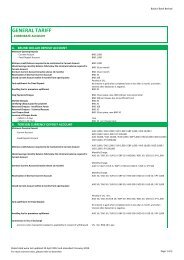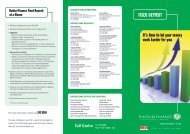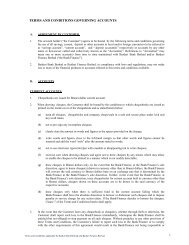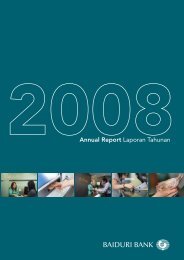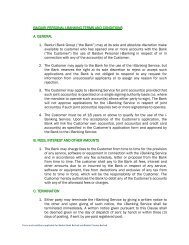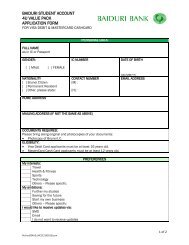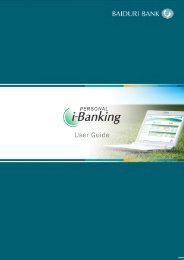Annual Report Laporan Tahunan - Baiduri Bank
Annual Report Laporan Tahunan - Baiduri Bank
Annual Report Laporan Tahunan - Baiduri Bank
Create successful ePaper yourself
Turn your PDF publications into a flip-book with our unique Google optimized e-Paper software.
Notes to Financial Statements<br />
December 31, 2008<br />
25 RISK MANAGEMENT OBJECTIVES AND POLICIES<br />
Accepting and managing risk is central to the business of the Group and is an important source of<br />
competitive advantage.<br />
The Board of Directors are accountable for establishing and maintaining an environment that manages risk<br />
in an effective and efficient manner. This includes a robust system of limits, controls and reporting<br />
processes. Management and senior executives track key performance indicators, investigates and reports<br />
on effectiveness of risk management systems to the Board of Directors. The Group’s internal audit department<br />
also provide an independent assessment of this process.<br />
The following discussion on risk management concentrates on the Group’s main areas of risk:<br />
(i)<br />
Credit risk<br />
Credit risk is the risk of financial loss that results from customers failing to meet their obligations.<br />
Credit risk arises primarily from lending-related activities and represents Group’s major risk type.<br />
The Board of Directors approves major prudential policies and limits that govern large customer<br />
exposures and industry concentration. The Board of Directors also appoints independent credit<br />
officers in each business areas. These credit officers would work with the line managers to ensure that<br />
approved policies are applied appropriately and achieve optimal returns on the Group’s risk<br />
exposure.<br />
In respect of its lending-related activities, management regularly review the amount of risk accepted<br />
in related to one borrower or groups of borrowers, industry segments, level of non-performing loans<br />
and adequacy of provisioning requirements.<br />
Exposure to credit risk is also managed in part by obtaining collateral. Some of the assets typically<br />
included as collateral are property, assignment of rental income, salary and deposit placement.<br />
(ii)<br />
Liquidity risk<br />
Liquidity risk is the risk that the Group is unable to meet its cashflow obligations as and when they fall<br />
due.<br />
To manage the risk, the Group monitors and maintains sufficient liquid assets to ensure that the liquidity<br />
risk exposure is managed and minimised.<br />
Additionally, the Group has to comply with the regulations and guidelines of Ministry of Finance in<br />
maintaining minimum cash balances with the Ministry of Finance.<br />
(iii)<br />
Interest/Financing rate risk<br />
Interest/financing rate risk is the risk of earnings and value of financial instruments caused by<br />
fluctuations in interest/financing rates.<br />
Sensitivity to interest/financing rates arises from the differences in the maturities and re-pricing dates<br />
of assets and liabilities. These differences are monitored and managed by management to ensure that<br />
the risk exposure is minimised. These includes actively reviewing its interest/financing rate to ensure<br />
that the Group receives an optimal and yet competitive interest/financing spread.<br />
42 <strong>Baiduri</strong> <strong>Bank</strong> <strong>Annual</strong> <strong>Report</strong> 2008



